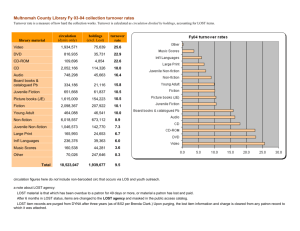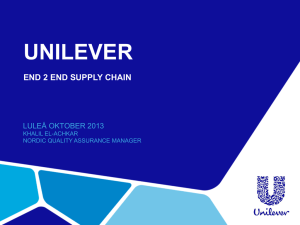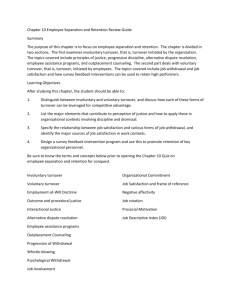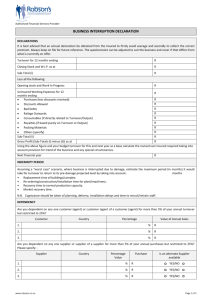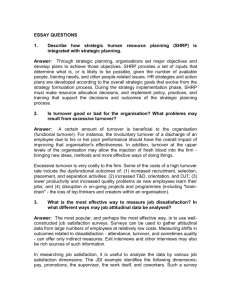current retail market of romanian. insights to improve of
advertisement
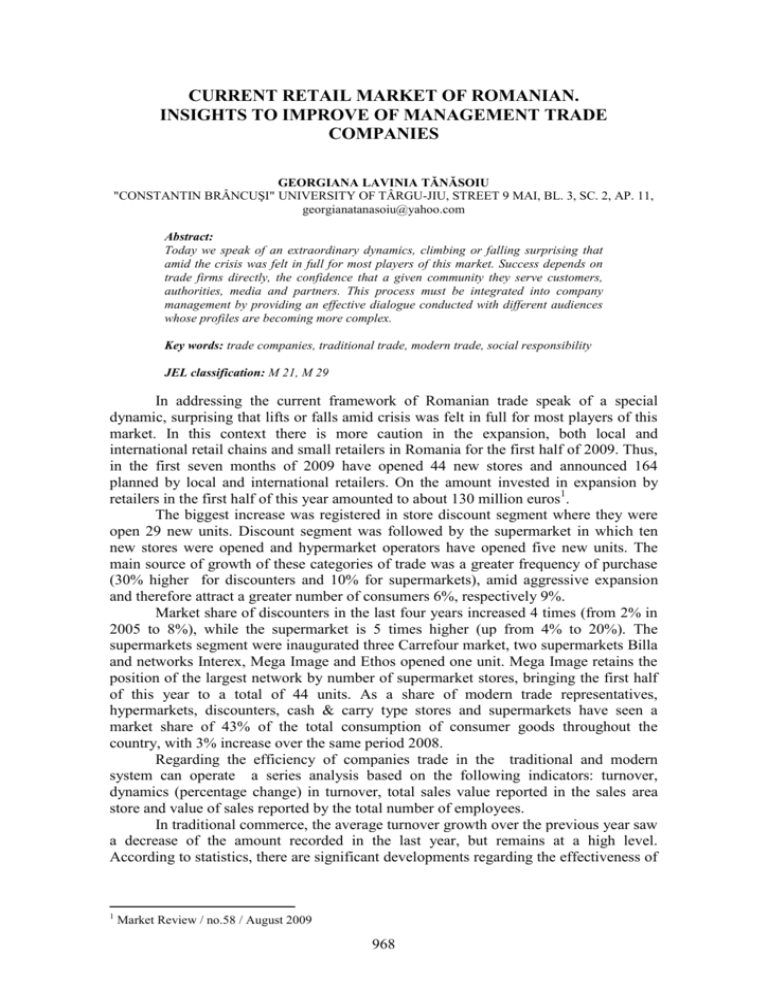
CURRENT RETAIL MARKET OF ROMANIAN. INSIGHTS TO IMPROVE OF MANAGEMENT TRADE COMPANIES GEORGIANA LAVINIA TĂNĂSOIU "CONSTANTIN BRÂNCUŞI" UNIVERSITY OF TÂRGU-JIU, STREET 9 MAI, BL. 3, SC. 2, AP. 11, georgianatanasoiu@yahoo.com Abstract: Today we speak of an extraordinary dynamics, climbing or falling surprising that amid the crisis was felt in full for most players of this market. Success depends on trade firms directly, the confidence that a given community they serve customers, authorities, media and partners. This process must be integrated into company management by providing an effective dialogue conducted with different audiences whose profiles are becoming more complex. Key words: trade companies, traditional trade, modern trade, social responsibility JEL classification: M 21, M 29 In addressing the current framework of Romanian trade speak of a special dynamic, surprising that lifts or falls amid crisis was felt in full for most players of this market. In this context there is more caution in the expansion, both local and international retail chains and small retailers in Romania for the first half of 2009. Thus, in the first seven months of 2009 have opened 44 new stores and announced 164 planned by local and international retailers. On the amount invested in expansion by retailers in the first half of this year amounted to about 130 million euros1. The biggest increase was registered in store discount segment where they were open 29 new units. Discount segment was followed by the supermarket in which ten new stores were opened and hypermarket operators have opened five new units. The main source of growth of these categories of trade was a greater frequency of purchase (30% higher for discounters and 10% for supermarkets), amid aggressive expansion and therefore attract a greater number of consumers 6%, respectively 9%. Market share of discounters in the last four years increased 4 times (from 2% in 2005 to 8%), while the supermarket is 5 times higher (up from 4% to 20%). The supermarkets segment were inaugurated three Carrefour market, two supermarkets Billa and networks Interex, Mega Image and Ethos opened one unit. Mega Image retains the position of the largest network by number of supermarket stores, bringing the first half of this year to a total of 44 units. As a share of modern trade representatives, hypermarkets, discounters, cash & carry type stores and supermarkets have seen a market share of 43% of the total consumption of consumer goods throughout the country, with 3% increase over the same period 2008. Regarding the efficiency of companies trade in the traditional and modern system can operate a series analysis based on the following indicators: turnover, dynamics (percentage change) in turnover, total sales value reported in the sales area store and value of sales reported by the total number of employees. In traditional commerce, the average turnover growth over the previous year saw a decrease of the amount recorded in the last year, but remains at a high level. According to statistics, there are significant developments regarding the effectiveness of 1 Market Review / no.58 / August 2009 968 using space and staff shops selling traditional trade (Table no.: 1. Performance indicators of traditional trade stores). Table no.: 1. Performance indicators of traditional trade stores variation (%) Indicator 2006 2007 2008 20072008 Average turnover 2.288.497 2.793.514 4.240.381 52 (ron) Average dynamics 35 20 32 60 of turnover (% to previous year) Average selling 17.744 20.693 26.706 29 space efficiency *(ron/sqm) Average efficiency 171.050 216.477 254.971 18 of sales staff (ron /person) variation (%) 20082006 85 -9 51 49 Source: Market Review / nr.59 / September 2009 Average turnover of operators in traditional trade grew strongly in 2008, for more detail, we note that significantly more group companies in 2008 achieved a turnover of medium and small groups of companies were with high turnover and low (Table no. 2. Statistical distribution of turnover). Also, the average turnover dynamics (arithmetic mean of the variation of turnover from the previous year) was close to the value of 2006, proof that 2008 was generally a year of accelerated growth (Table no. 3. Statistical distribution of variation of turnover from the previous year). Efficiency of using space sales continued to improve at a higher rate than previous years. Also, staff efficiency had a positive development, but with a slower pace compared with previous years. Traders note that the traditional group recording lower minimum values of these indicators and the enlarged group which obtained the maximum. Table no. 2. Statistical distribution of Table no. 3. Statistical distribution of variation of turnover from the previous turnover year Turnover Percentage companies (%) Changes in Percentage companies turnover (%) from 2006 2007 2008 2006 2007 2008 previous year Below 0.5 33,8% 27,3 27,9% decrease 20 10,7 13,6 million ron % Between 33,7% 32,5 27,9% Growth in 14,1 25,3 13,6 0.5 and 2 % 10% million ron Averages based on data from stores and chain stores with sales area (ie the average surface) of less than 200 m 969 Table no. 2. Statistical distribution of Table no. 3. Statistical distribution of variation of turnover from the previous turnover year Turnover Percentage companies (%) Changes in Percentage companies turnover (%) from 2006 2007 2008 2006 2007 2008 previous year Between 2 23,8% 19,5 24,6% Growth 10- 29,5 37,3 32,2 and 5 % 25% milion ron Between 5 5% 14,3 8,2% Growth 25- 21,9 17,3 20,3 and 10 % 50% million ron Over 10 3,7% 6,5% 11,5% Growth 50- 11,5 5,3 13,6 milion ron 100% Growth 100% 3,8 4 5,1 and over Source: Market Review / nr.59 / September 2009 According to statistics provided by Nielsen Market Research Institute, on the retail market developments, we have witnessed a decrease in average store size (21-40 m) in 2008 by 7% compared to 2007, and continued decline in 2009. Mark the same downward trend kiosks and large food stores. Instead, we witnessed the growth of small shops for food sector in 2007 continued its upward trend. Also, you can see an explosion in the hypermarkets, which have increased by 55% in 2008 compared to March 2007, marked upward trend in 2009 (Fig. no.: 1. Evolution of retail market in Romania 2006-2009). Fig. no.: 1. Evolution of retail market in Romania 2006-2009 Source: Nielsen According to the National Institute of Statistics, turnover in retail trade decreased by 6.1% in December 2009 over the same months of 2008, mostly due to Averages based on data from stores and chain stores with sales area (ie the average surface) of less than 200 m 970 significant decrease in fuel sales and non-food sales decline and foodstuffs. It can be added to estimates of retail trade managers, whereby the first three months of 2010 is expected to moderate decrease in economic activity (short term balance -10%), both total sales volume of goods and the number of orders to suppliers by the business units. However, managers in May forecast for the next three months, and a moderate decrease in number of employees in this sector (short term balance -11%) and an increase in retail prices (short term balance +26%). According to Isra Center study2 in the population are different perceptions regarding traditional trade (small shops) and modern commerce (large stores). This can be treated in terms of the following indicators: frequency of visits to shopping and delimitation of the period of most active week time frame in terms of visits, identifying how the budget is distributed for the acquisition of various categories of products purchased, quantity acquired, tracking the main reasons that attract buyers in both commercial formats and setting the general level of satisfaction to them. According to survey results, most of the urban population (82%) participate in making purchases of consumer goods for the household, women are involved in a significantly greater extent (91%) in this process, compared with men (71%). Different behaviors in terms of results and analysis of age segments, the most active buyers are those of category between 50 and 60 years (86%) and those less involved, young people between 20 and 29 years (77%). Almost all respondents said they purchase Consumer goods also in large format stores - hypermarkets, cash & carry, supermarkets - and in the small format - mini, kiosk, boutique, grocery store, general store. Therefore, both modern retail and traditional trade play important roles in the Romanians' purchasing habits. In terms of frequency of purchase, small commercial establishments are visited more often - six times per week, compared with an average of once a week, where the large consumer orientation due to the convenience stores and the additional purchases. In their case, persons in the age group between 50 and 60 years are most active, buying their daily trade of these formats. Modern retail is preferred, in particular, to make shopping on weekends (45%) and especially between the hours 16.00 to 22.00 (53%), program that overlaps in the case of several subjects, with at the post office. Less is approved Monday, Tuesday and Wednesday (5%) and Thursday and Friday (11%) but 33% of respondents stated that also go shopping during the week. Visitors 'weekend' most active are those with higher education (51%). Also, small shops, traditional, are preferred throughout the week (70%), especially in the hours from 16.00 to 20, 00 (33%) and 8.00 to 12.00 (26%). If they do not refer to substantial differences in terms of education level of clients who pass the threshold. However, the strong influence of modern commerce felt in budget shopping, 62% of the available money is directed to this form of distribution of consumer goods, compared to 38%, as unobtrusive traditional stores. Among the main attractions for modern stores offer variety of products placed first, with 81% of entries, followed by affordability (67%) that are well supplied (53%). Residents of small towns and medium view more promotions and contests, and product availability, compared to national average. Offer prices and regularity of supply are the strengths of modern retail, but the kindness of staff is poor, this being found only 1% of respondents. Grounds of appeal where traditional trade is changing, says the study Isra Center3, most buyers considering smaller stores because of their proximity (76%). Other strengths are the lack of congestion and the fact that many customers relate more easily to staff the store. As a general remark, it appears the award several qualities of modern trade, compared with the traditional. Thus, buyers are more satisfied 2 3 Market Review / nr.64 / January 2009 Isra Study Center-August 2009 971 with large format stores, average score on a scale of 1 to 5, being 3.83 compared to 3.58, obtained as a traditional trade. In this context, traders will seek solutions, after the crisis has affected the substantial international sales that will result in promotion over promotion or orientation segments to compensate for the volume of business losses from lower consumption. Success depends on trade firms directly, the confidence that a given community they serve customers, authorities, media and partners. This process must be integrated into company management by providing an effective dialogue conducted with different audiences whose profiles are becoming more complex. Thus, each entity is constantly looking for information, which I facilititeze making, but also a sense that is not always compatible with the notion of rationality or utility. Social Responsibility offers retailers the chance to be involved in multiple aspects in society, to achieve voluntary and consumer products marketed to fight together for the principles of sustainable development. Every company has trade links with the local community made up of customers, suppliers, competitors, former or potential employees, opinion groups, shareholders, local authorities, representatives of local media, national or international. From this variety of audiences, there are several levels of involvement of firms trading in community life4. First, a trading company out basic activities: they pay taxes, obey the law, honestly and honorably negotiate with staff, suppliers and shareholders. Secondly, the company consider the environmental effects of its activities and seeks to minimize negative effects by controlling pollution and avoiding the misuse of products sold. At this level the trade company will work more in spirit than the letter of the law by trying to anticipate trends in legislation and customer behavior. These two levels manageriatul covers what are considered retailers of their responsibility towards society and interacting groups. The third level of involvement of the business aspects of trade concerns: the environment healthy, the best prospects for use of resources, the most responsible customers, etc.. Almost as anxious to do something about the problems that prevent normal development society. One way to involve a trade company in support of the local community is the creation and support of associations, which will develop projects of local interest. These activities can be carried out by their actual trading firm or a consulting firm and concerns5: donations, employee involvement in running the company through voluntary programs, training, social projects, provision of facilities, visitor centers, day open environment, public speaking, media relations, etc Engaging in commercial activity responsible for ensuring sustainable economic success and trade company integrating voluntary social and environmental considerations. Commercial activity responsible means to obtain direct benefits to the firm and long-term competitiveness by: - customer satisfaction and other business groups interested in trade activities; - contributions to society; -environmental impact of company management. In practice, the charge may proceed with the business: investment in employees, sustainable jobs for the unemployed, support good causes, encouraging employees to volunteer activities, supporting local community groups, implementation of environmental actions, etc.. If I had to start from the question "Why engage in the business responsible?" Response that is linked accountability contribute to long-term competitive advantage 4 5 Peach, L.– ,,Effective Corporate Relations”, McGraw-Hill, Maidenhead, 1987, p. 191 Harrison, S. – ,,Public Relation - An Introduction”, Routledge, London, 1995, p.p. 127-130 972 and foster situations, "win-win" that lead to business success. Basically, this theory translates into: - gaining reputation and trust; - retain and attract customers; - community confidence; - environmental protection; - employee satisfaction. Also responsible for business activities conducted by retailers means maintaining and improving long-term competitive advantage of business and ensuring its continued viability. It improves the competitiveness of a firm over its competitors because of reputation, brand and / or quality, or superior products and services sold. Incentives responsible business activities are represented by internal motivation, the chain of customers and suppliers, local communities, financial and insurance system, etc.. Stimulating ethical behavior of employees has a pragmatic moral purpose, creating a positive image of the company. Acting in a coherent and modern thinking, modern trade company can turn its policy of social benefits of sustainable economic impact. This is alternative, compared with options to companies wishing to register large gains in short time and can not strengthen its long-term market. It requires firm managers to pay greater attention to trade moral significance of firm actions and consequences of these actions on society. Practice shows that the speculative business is not viable long term. They create tensions in relations with the social environment, leading to loss of customers, sometimes in company liquidation. In trade matters to be taken into account by firms are fair and moral behavior, profits, efficiency, effectiveness, opportunity, security, stability, predictability, partnership and cooperation, environmental protection, customer and employee satisfaction, quality products and services, etc.. The binomial-commerce firm external environment may be considered a partnership relationship and the consumer. Thus, the concept of consumer responsibility can be a challenge in a world overrun by messages urging continuously purchase. However, it seems that most people will clean air and resources for future generations. Most consumers really want a better world, even if this desire is sometimes covered by discounts and promotional offers. Who is the socially responsible consumer? This question can lay down a multitude of issues that can contribute to shaping its profile: is sensitive to society's problems, always looking for information about the products they offer, both on producers and traders about, is interested in companies that conduct market compete to occupy a place in their minds, is willing to pay more for a product provided it is part of a social project. Basically a responsible consumer is a consumer who acknowledges the impact that each of his choices have on the community. Consumer empowerment process can be considered complex especially when there is a tradition in this respect. Thus, the series features the process of empowerment can be mentioned: - main objective is to obtain voluntary adherence to consumers indirectly support a cause of community. The communication company tries to make the consumer responsible choices. - the actions of social communication company can target several audiences primarily consumers, other companies - by these initiatives, the company provides additional value product that social value; - although the effects are short term and may bid on a propagation time across the company. 973 In the category of policy factors favoring trade management companies to introduce and extend the concept of socially responsible consumer can mention: - rendering the supply of products, consumers face a difficult choice of brands and training preferences, such messages are sensitive to the emotional, social question, almost everyone identifies a new role, that of advocate; - given that the commercial communication companies reached a saturation threshold, social communication becomes more effective; - countering the actions of competitors; - achieve market differentiation; - while other techniques involve communication is impersonal and remote from public social communication related to consumer empowerment tends to have a character directly, personally; - firms desire to increase awareness and create a good image among the public. In this context, companies concerned about trying to gain his attention and disseminating a series of consumer confidence about its organization and registry values. Thus, there are several ways to incorporate socially responsible practices in the marketing mix elements that directly concerns the behavior of, respectively: - labeling and packaging practices, including: warnings about potential health risks, describe the product components, the declaration of origin, information on recycling products and packaging; - advertising practices, including: accuracy of the information submitted in commercials advertising products for children, use of images stereotipizate confidentiality of personal information; - sales practices, including: transparency and fairness of credit instruments, selling products in accordance with relevant standards, fair prices; - good distribution practices, including: access to alternative products available at lower prices, physical access for persons with disabilities, access to insurance. In the literature have imposed a number of terms in connection with operating responsibility firms trade issues, namely: - fair trade is a trade law, just based on specific commitments and partnerships with the objective of enhancing and developing livelihoods of farmers and artisans. - trade ethical values take into account the human condition in terms of moral principles and their role in social life and meet a voluntary initiative of companies or companies based on a code of conduct with variable content; - pay attention to sustainable trade products production (natural resources management, health, environment) and their life cycle; - joint trade aims to raise funds to support charitable projects selected by that company, firm, association or by a donor. Social responsibility must be detached from these forms of social involvement, and philanthropy or sponsorship and should take the form of complex programs, social involvement strategies that integrate medium and long term development strategy and communications company and take into account the interests of all interested groups of shareholders, owners, employees, business partners, suppliers, customers, creditors, consumers and distributors to the local community in which it operates. Currently, there are few companies not only trade, which apply to social responsibility strategies and an increasing number of them carry low social impact assessments and environmental impact of business activities, their social investment programs. 974 REFERENCES 1. 2. 3. 4. 5. Harrison, S. – ,,Public Relation - An Introduction”, Routledge, London, 1995, p.p. 127-130 Peach, L. – ,,Effective Corporate Relations”, McGraw-Hill, Maidenhead, 1987, p. 191 Isra Study Center-August 2009 Market Review/no.58/August 2009 Market Review/nr.64/January 2009 975



